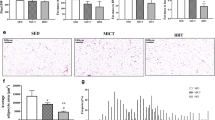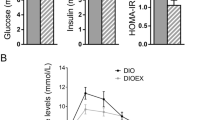Abstract
Purpose
Aging is associated with changes in glucose homeostasis related to both decreased insulin secretion and/or impaired insulin action, contributing to the high prevalence of type 2 diabetes (T2D) in the elderly population. Additionally, studies are showing that chronically high levels of circulating insulin can also lead to insulin resistance. In contrast, physical exercise has been a strategy used to improve insulin sensitivity and metabolic health. However, the molecular alterations resulting from the effects of physical exercise in the liver on age-related hyperinsulinemia conditions are not yet fully established. This study aimed to investigate the effects of 7 days of aerobic exercise on hepatic metabolism in aged hyperinsulinemic rats (i.e., Wistar and F344) and in Slc2a4+/− mice (hyperglycemic and hyperinsulinemic mice).
Results
Both aged models showed alterations in insulin and glucose tolerance, which were associated with essential changes in hepatic fat metabolism (lipogenesis, gluconeogenesis, and inflammation). In contrast, 7 days of physical exercise was efficient in improving whole-body glucose and insulin sensitivity, and hepatic metabolism. The Slc2a4+/− mice presented significant metabolic impairments (insulin resistance and hepatic fat accumulation) that were improved by short-term exercise training. In this scenario, high circulating insulin may be an important contributor to age-related insulin resistance and hepatic disarrangements in some specific conditions.
Conclusion
In conclusion, our data demonstrated that short-term aerobic exercise was able to control mechanisms related to hepatic fat accumulation and insulin sensitivity in aged rodents. These effects could contribute to late-life metabolic health and prevent the development/progression of age-related T2D.





Similar content being viewed by others
Data availability statement
The data that support the findings of this study are available from the corresponding author upon reasonable request.
References
Smith HJ, Sharma A, Mair WB (2020) Metabolic communication and healthy aging: where should we focus our energy? Dev Cell. https://doi.org/10.1016/j.devcel.2020.06.011
Park MH, Kim DH, Lee EK et al (2014) Age-related inflammation and insulin resistance: a review of their intricate interdependency. Arch Pharm Res 37(12):1507–1514. https://doi.org/10.1007/s12272-014-0474-6
Roden M, Shulman GI (2019) The integrative biology of type 2 diabetes. Nature 576(7785):51–60. https://doi.org/10.1038/s41586-019-1797-8
Sheedfar F, Di BS, Koonen D, Vinciguerra M (2013) Liver diseases and aging: friends or foes? Aging Cell 12(6):950–954. https://doi.org/10.1111/acel.12128
Kahn BB (1998) Type 2 diabetes: when insulin secretion fails to compensate for insulin resistance. Cell 92(5):593–596
Corkey BE (2012) Banting lecture 2011: hyperinsulinemia: cause or consequence? Diabetes 61(1):4–13. https://doi.org/10.2337/db11-1483
Janssen JAMJL (2021) Hyperinsulinemia and its pivotal role in aging, obesity, type 2 diabetes, cardiovascular disease and cancer. Int J Mol Sci 22(15):7797. https://doi.org/10.3390/ijms22157797
Dankner R, Chetrit A, Shanik MH, Raz I, Roth J (2012) Basal state hyperinsulinemia in healthy normoglycemic adults heralds dysglycemia after more than two decades of follow up. Diabetes Metab Res Rev. https://doi.org/10.1002/dmrr.2322
Thomas DD, Corkey BE, Istfan NW, Apovian CM (2019) Hyperinsulinemia: an early indicator of metabolic dysfunction. J Endocr Soc 3(9):1727–1747. https://doi.org/10.1210/js.2019-00065
Cen HH, Hussein B, Botezelli JD et al (2022) Human and mouse muscle transcriptomic analyses identify insulin receptor mRNA downregulation in hyperinsulinemia-associated insulin resistance. FASEB J. https://doi.org/10.1096/fj.202100497RR
Li Q, Hagberg CE, Silva Cascales H et al (2021) Obesity and hyperinsulinemia drive adipocytes to activate a cell cycle program and senesce. Nat Med 27(11):1941–1953. https://doi.org/10.1038/s41591-021-01501-8
Duckworth WC, Bennett RG, Hamel FG (1998) Insulin degradation: progress and potential*. Endocr Rev. https://doi.org/10.1210/edrv.19.5.0349
Fink RI, Revers RR, Kolterman OG, Olefsky JM (1985) The metabolic clearance of insulin and the feedback inhibition of insulin secretion are altered with aging. Diabetes. https://doi.org/10.2337/diab.34.3.275
Chang AM, Halter JB (2003) Aging and insulin secretion. Am J Physiol Metab 284(1):E7–E12. https://doi.org/10.1152/ajpendo.00366.2002
Geloneze B, de Oliveira MS, Vasques ACJ, Novaes FS, Pareja JC, Tambascia MA (2014) Impaired incretin secretion and pancreatic dysfunction with older age and diabetes. Metabolism 63(7):922–929. https://doi.org/10.1016/j.metabol.2014.04.004
Samuel VT, Shulman GI (2018) Nonalcoholic fatty liver disease as a nexus of metabolic and hepatic diseases. Cell Metab 27(1):22–41. https://doi.org/10.1016/j.cmet.2017.08.002
Lee JH, Rhee PL, Lee JK et al (1998) Role of hyperinsulinemia and glucose intolerance in the pathogenesis of nonalcoholic fatty liver in patients with normal body weight. Korean J Intern Med. https://doi.org/10.3904/kjim.1998.13.1.10
Thyfault JP, Scott RR (2020) Exercise combats hepatic steatosis: potential mechanisms and clinical implications. Diabetes. https://doi.org/10.2337/dbi18-0043
Muñoz VR, Gaspar RC, Crisol BM et al (2017) Physical exercise reduces pyruvate carboxylase (PCB) and contributes to hyperglycemia reduction in obese mice. J Physiol Sci. https://doi.org/10.1007/s12576-017-0559-3
Muñoz VRVR, Gaspar RCRC, Kuga GKGK et al (2018) Exercise decreases CLK2 in the liver of obese mice and prevents hepatic fat accumulation. J Cell Biochem 119(7):5885–5892. https://doi.org/10.1002/jcb.26780
Batista TM, Haider N, Kahn CR (2021) Defining the underlying defect in insulin action in type 2 diabetes. Diabetologia. https://doi.org/10.1007/s00125-021-05415-5
Baboota RK, Spinelli R, Erlandsson MC et al (2022) Chronic hyperinsulinemia promotes human hepatocyte senescence. Mol Metab 64:101558. https://doi.org/10.1016/j.molmet.2022.101558
Meijnikman AS, van Olden CC, Aydin Ö et al (2022) Hyperinsulinemia is highly associated with markers of hepatocytic senescence in two independent cohorts. Diabetes 71(9):1929–1936. https://doi.org/10.2337/db21-1076
Ogrodnik M, Miwa S, Tchkonia T et al (2017) Cellular senescence drives age-dependent hepatic steatosis. Nat Commun 8(1):15691. https://doi.org/10.1038/ncomms15691
Kumari R, Jat P (2021) Mechanisms of cellular senescence: cell cycle arrest and senescence associated secretory phenotype. Front cell Dev Biol 9:645593. https://doi.org/10.3389/fcell.2021.645593
Muñoz VR, Gaspar RC, Kuga GK et al (2018) The effects of aging on rho-kinase and insulin signaling in skeletal muscle and white adipose tissue of rats. J Gerontol Ser A. https://doi.org/10.1093/gerona/gly293
Reaven E, Wright D, Mondon CE, Solomon R, Ho H, Reaven GM (1983) Effect of age and diet on insulin secretion and insulin action in the rat. Diabetes 32(2):175–180. https://doi.org/10.2337/diab.32.2.175
Reaven E, Curry D, Moore J, Reaven G (1983) Effect of age and environmental factors on insulin release from the perfused pancreas of the rat. J Clin Investig 71(2):345–350. https://doi.org/10.1172/JCI110775
Shanik MH, Xu Y, Skrha J, Dankner R, Zick Y, Roth J (2008) Insulin resistance and hyperinsulinemia: is hyperinsulinemia the cart or the horse? Diabetes Care. https://doi.org/10.2337/dc08-s264
Marangou AG, Weber KM, Boston RC et al (1986) Metabolic consequences of prolonged hyperinsulinemia in humans. Evidence for induction of insulin insensitivity. Diabetes. https://doi.org/10.2337/diab.35.12.1383
Ward GM, Walters JM, Aitken PM, Best JD, Alford FP (1990) Effects of prolonged pulsatile hyperinsulinemia in humans. Enhancement of insulin sensitivity. Diabetes. https://doi.org/10.2337/diab.39.4.501
Ferrannini E, Natali A, Bell P, Cavallo-Perin P, Lalic N, Mingrone G (1997) Insulin resistance and hypersecretion in obesity. J Clin Investig. https://doi.org/10.1172/JCI119628
Mehran AE, Templeman NM, Brigidi GS et al (2012) Hyperinsulinemia drives diet-induced obesity independently of brain insulin production. Cell Metab 16(6):723–737. https://doi.org/10.1016/j.cmet.2012.10.019
Kurauti MA, Ferreira SM, Soares GM et al (2019) Hyperinsulinemia is associated with increasing insulin secretion but not with decreasing insulin clearance in an age-related metabolic dysfunction mice model. J Cell Physiol. https://doi.org/10.1002/jcp.27667
Gumbiner B, Polonsky KS, Beltz WF, Wallace P, Brechtel G, Fink RI (1989) Effects of aging on insulin secretion. Diabetes. https://doi.org/10.2337/diab.38.12.1549
Marmentini C, Soares GM, Bronczek GA et al (2021) Aging reduces insulin clearance in mice. Front Endocrinol (Lausanne). https://doi.org/10.3389/fendo.2021.679492
Tricò D, Natali A, Arslanian S, Mari A, Ferrannini E (2018) Identification, pathophysiology, and clinical implications of primary insulin hypersecretion in nondiabetic adults and adolescents. JCI Insight. https://doi.org/10.1172/jci.insight.124912
Rhee EJ, Lee WY, Cho YK, Kim BI, Sung KC (2011) Hyperinsulinemia and the development of nonalcoholic fatty liver disease in nondiabetic adults. Am J Med. https://doi.org/10.1016/j.amjmed.2010.08.012
Ardigò D, Numeroso F, Valtueña S et al (2005) Hyperinsulinemia predicts hepatic fat content in healthy individuals with normal transaminase concentrations. Metabolism. https://doi.org/10.1016/j.metabol.2005.05.027
Mehta SR, Godsland IF, Thomas EL et al (2012) Intrahepatic insulin exposure, intrahepatocellular lipid and regional body fat in nonalcoholic fatty liver disease. J Clin Endocrinol Metab. https://doi.org/10.1210/jc.2011-2430
Michael MD, Kulkarni RN, Postic C et al (2000) Loss of insulin signaling in hepatocytes leads to severe insulin resistance and progressive hepatic dysfunction. Mol Cell 6(1):87–97. https://doi.org/10.1016/S1097-2765(05)00015-8
Fisher SJ, Kahn CR (2003) Insulin signaling is required for insulin’s direct and indirect action on hepatic glucose production. J Clin Investig 111(4):463–468. https://doi.org/10.1172/JCI16426
Barzilai N, Ferrucci L (2012) Insulin resistance and aging: a cause or a protective response? J Gerontol Ser A Biol Sci Med Sci. https://doi.org/10.1093/gerona/gls145
Hotamisligil GS (2006) Inflammation and metabolic disorders. Nature 444(7121):860–867. https://doi.org/10.1038/nature05485
Petersen AMW, Pedersen BK (2005) The anti-inflammatory effect of exercise. J Appl Physiol 98(4):1154–1162. https://doi.org/10.1152/japplphysiol.00164.2004
Maude H, Sanchez-Cabanillas C, Cebola I (2021) Epigenetics of hepatic insulin resistance. Front Endocrinol (Lausanne). https://doi.org/10.3389/fendo.2021.681356
Spinelli R, Parrillo L, Longo M et al (2020) Molecular basis of ageing in chronic metabolic diseases. J Endocrinol Investig 43(10):1373–1389. https://doi.org/10.1007/s40618-020-01255-z
Doria A, Patti M-E, Kahn CR (2008) The emerging genetic architecture of type 2 diabetes. Cell Metab 8(3):186–200. https://doi.org/10.1016/j.cmet.2008.08.006
Hoene M, Kappler L, Kollipara L et al (2021) Exercise prevents fatty liver by modifying the compensatory response of mitochondrial metabolism to excess substrate availability. Mol Metab 54:101359. https://doi.org/10.1016/j.molmet.2021.101359
Fredrickson G, Barrow F, Dietsche K et al (2021) Exercise of high intensity ameliorates hepatic inflammation and the progression of NASH. Mol Metab 53:101270. https://doi.org/10.1016/j.molmet.2021.101270
Yang J, Sáinz N, Félix-Soriano E et al (2021) Effects of long-term DHA supplementation and physical exercise on non-alcoholic fatty liver development in obese aged female mice. Nutrients 13(2):501. https://doi.org/10.3390/nu13020501
Gustafson B, Nerstedt A, Smith U (2019) Reduced subcutaneous adipogenesis in human hypertrophic obesity is linked to senescent precursor cells. Nat Commun 10(1):2757. https://doi.org/10.1038/s41467-019-10688-x
Spinelli R, Florese P, Parrillo L et al (2022) ZMAT3 hypomethylation contributes to early senescence of preadipocytes from healthy first-degree relatives of type 2 diabetics. Aging Cell. https://doi.org/10.1111/acel.13557
Dutta S, Sengupta P (2016) Men and mice: relating their ages. Life Sci. https://doi.org/10.1016/j.lfs.2015.10.025
Muñoz VR, Gaspar RC, Kuga GK et al (2018) Exercise increases rho-kinase activity and insulin signaling in skeletal muscle. J Cell Physiol 233(6):4791–4800. https://doi.org/10.1002/jcp.26278
Folch J, Lees M, Stanley GHS (1957) A simple method for the isolation and purification of total lipides from animal tissues. J Biol Chem 226(1):497–509. https://doi.org/10.1016/S0021-9258(18)64849-5
Braga RR, Crisol BM, Brícola RS et al (2021) Exercise alters the mitochondrial proteostasis and induces the mitonuclear imbalance and UPRmt in the hypothalamus of mice. Sci Rep. https://doi.org/10.1038/s41598-021-82352-8
Funding
This work was supported by FAEPEX, the National Council for Scientific and Technological Development (CNPq; case numbers 303571/2018-7; 140285/2016-4; 442542/2014-3 and 306535/2017-3), the Coordination for the Improvement of Higher Education Personnel (CAPES; finance code 001), and the São Paulo Research Foundation (FAPESP; case numbers 2015/26000-2, 2016/18488-8, 2018/20872-6, 2019/11820-5, 2020/13443-1 and 2021/08692-5).
Author information
Authors and Affiliations
Contributions
VRM and JRP wrote the paper and were ultimately responsible for the experiments in this study. VRM, RCG, RLD, RFLV, GCA, BMC, designed and performed experiments with animals. MCSM and FMS designed and performed the cell culture experiments. FMS, ASRS, CRC, ERR, DEC, JCST, ILPB, and JRP contributed to the discussion and laboratory support. All the authors have read and approved this manuscript.
Corresponding author
Ethics declarations
Conflict of interest
The authors of this study have no competing interests to declare.
Ethical approval
All the interventions involving humans were performed after signing of the consent term and approval from the Ethics Committee of the University of Campinas (n°: 1.967.450/2017).
Informed consent
In the human study, informed consent was obtained from all participants.
Additional information
Publisher's Note
Springer Nature remains neutral with regard to jurisdictional claims in published maps and institutional affiliations.
Supplementary Information
Below is the link to the electronic supplementary material.
Rights and permissions
Springer Nature or its licensor (e.g. a society or other partner) holds exclusive rights to this article under a publishing agreement with the author(s) or other rightsholder(s); author self-archiving of the accepted manuscript version of this article is solely governed by the terms of such publishing agreement and applicable law.
About this article
Cite this article
Muñoz, V.R., Gaspar, R.C., Mancini, M.C.S. et al. Short-term physical exercise controls age-related hyperinsulinemia and improves hepatic metabolism in aged rodents. J Endocrinol Invest 46, 815–827 (2023). https://doi.org/10.1007/s40618-022-01947-8
Received:
Accepted:
Published:
Issue Date:
DOI: https://doi.org/10.1007/s40618-022-01947-8




